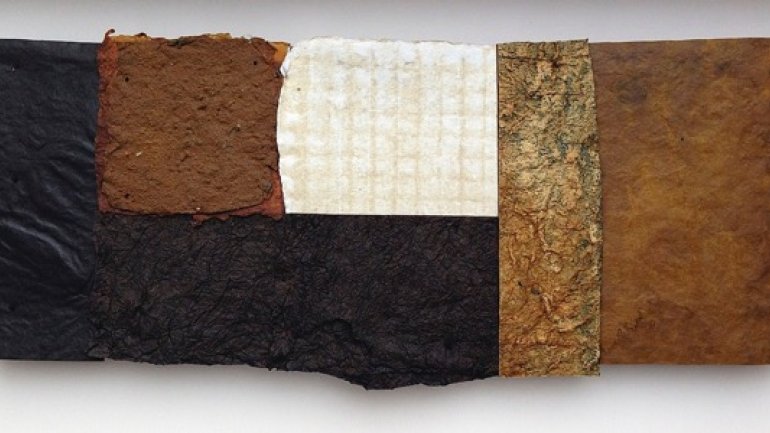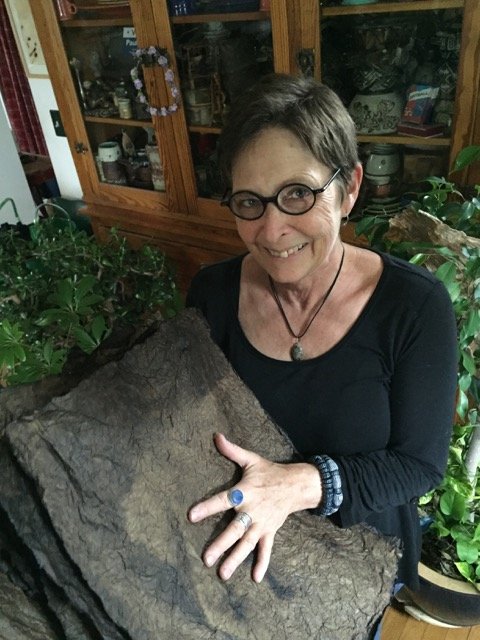Five Questions Salon Edition with Mary Hark
Our second Library Salon Series event of the spring dives into the many layers of papermaking. Paper artist and faculty member at the University of Wisconsin–Madison faculty member Mary Hark will be talking about her practice and her many community projects both locally and internationally. We were delighted to catch up with Mary before the salon to see what she is excited to share next week.
Tell us a little bit about yourself and your background.
I’m a Midwesterner, born and educated here. I have two wonderful grown-up daughters who are both doing creative work they love. I finished my graduate work at the Art Institute of Chicago. Generous and demanding teachers at SAIC provided a tremendous foundation for the life I built after earning the MFA. While I am on the faculty in Madison, I frequently come to St. Paul, where I have a home in the Frogtown neighborhood. I am a production papermaker who makes small editions of handmade paper in collaboration with book designers and artists, and I also make paper and textile wall works – collages informed by the physical environments in which I live and work. Most recently, these constructed paintings respond to the physical topography of central Minnesota and south-central Wisconsin, and the built environment of Kumasi, Ghana, where I spend time each year working on a papermaking project and researching textile traditions. I am coordinator of the Textile and Fashion Program in the Design Studies Department at the University of Wisconsin–Madison, working with graduate and undergraduate art and design students who are interested in papermaking and textiles.
Of all the different art mediums, what drew you to papermaking?
I came to paper through fiber and material studies, rather than through printmaking as many papermakers do. It was in many ways an unexpected gift from the universe. Tim Barrett, founding director of the University of Iowa Center for the Book, arrived on campus to establish what has become an internationally regarded paper and book program. He started this work during the time I was an MA candidate in fibers studying with professor Naomi Schedl, and with some good luck I landed a work-study position his very first semester and was on the team that helped establish the paper studio. This was my first introduction to the craft. In those first classes I met friends who continue to be valued colleagues: Jana Pullman, Jocelyn Chateauvert, MA McKellar, and others. Initially I was able to easily understand paper as a continuum of a textile palette – extending the soft and absorbent material qualities of cloth, as well as the conceptual references. And, I love process: all that water! Buckets of raw material and pulp! The transformation of that raw material into something new that still carries the DNA of the plant or textile; I find all of this beautiful and engaging. It was seamless integrating papermaking into my budding studio practice that was grounded in textiles.
The various communities that you have built through your projects and teaching are astounding. How has that contributed to your own artistic practice?
First, this is not as astounding as you imply. Teaching has always been an important part of my practice. I am wired to share what I love with others. I’m sure this comes from the way I was raised. It is easy for me to see ways of sharing my work with the communities in which I live and work in. And it is fun. The papermaking process is accessible. While masterful papermaking demands all the attention of of any fine craft: a deep understanding of the tools and materials, physical control and lots of practice, and a personal vision for the work that is driven by our imaginations; making a simple piece of paper can be easily experienced by anyone, and the transformation of botanical or textile material into beautiful sheets of paper is undoubtably magical. Working with others on projects that are collaboratively designed or in which all involved are mutually committed to an outcome is a powerful way to get to know each other. It is deeply satisfying to build community around a creative activity. Having the opportunity to share and learn from colleagues and students is something I am profoundly grateful for and without any doubt has contributed to the way I understand the world, and consequently becomes part of what I draw upon in direct and subtle ways in my creative practice.
Establishing a paper mill is an incredible feat in itself, but to do so overseas must have been something else entirely. Can you briefly share some of the challenges and successes you faced when opening the paper mill in Ghana?
You might have heard the saying “do the work that finds you.” The project in Ghana was unexpected and very much a work in progress. It has been incredibly exciting and interesting, and of course has also been challenging. Working between cultures and economies has been an opportunity to acknowledge what I don’t know. Considering and reconsidering what success is, learning to listen, and applying my expertise in unfamiliar situations has taught me so much. How lucky I am to have work in Ghana! It is an exceptionally beautiful place: the textiles are astounding, the music, the openness, and generosity of the people I work with. After a decade of coming and going, it has become one of my homes and is home to some of my dearest friends. While there are frustrations that come from personal misunderstandings, working in a culture different than my own, or setbacks due to systems or institutions I don’t know how to navigate, there are also moments when all of us who are working together see we have done something beautiful, and we all know it together; these are truly significant moments where our differences fall away. I am drawn to the complications that arise from making my way through this work. I feel deeply grateful that I have the opportunity to be involved in this project.
What’s next for you? Do you have any projects lined up that you’re excited to share?
I will keep plugging away at the work in Ghana. It feels like we are at a precipice; that we might become what we have imagined before too long. But no matter what, I hope to stayed involved with the work there. I love teaching at UW–Madison, but am constantly trying to find balance between the demands of the university and the time I need to devote to my studio practice. I am more aware than ever of the preciousness of time. A very exciting emerging project is our dream of establishing a real working paper mill at the newly opened Frogtown Farm in St. Paul. I’m working closely with my dear friend and neighbor Soyini Guyton, who is a founding leader in that enterprise. Along with artist Seitu Jones, we are developing plans for the establishment of a paper studio that uses bio-waste from the farm to produce high quality papers. We are imagining a real working mill, doing production work that also has accompanying programing such as apprenticeships for neighborhood students, exhibitions, artist-in-residence opportunities – we can dream! And I’ll keep making stacks of beautiful paper. I look forward to the unexpected commissions from local and national book designers; to work collaboratively on these projects is great fun.
This activity is made possible by the voters of Minnesota through a Minnesota State Arts Board Operating Support grant, thanks to a legislative appropriation from the arts and cultural heritage fund.





